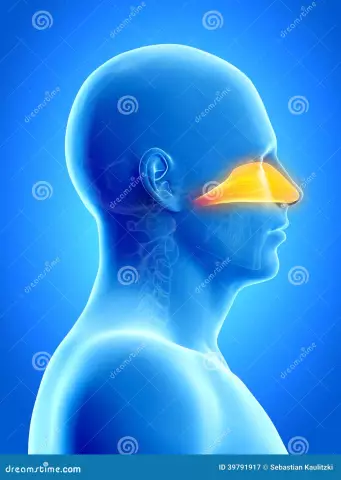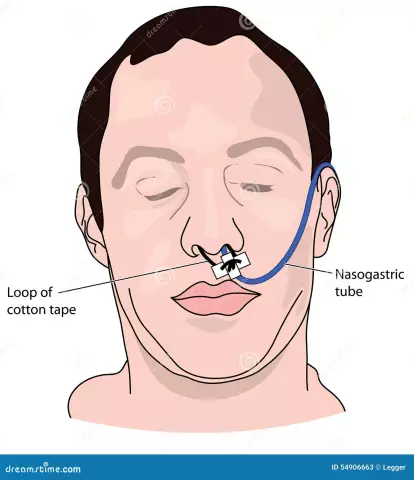- Author Rachel Wainwright [email protected].
- Public 2023-12-15 07:39.
- Last modified 2025-11-02 20:14.
Kromoglin
Kromoglin: instructions for use and reviews
- 1. Release form and composition
- 2. Pharmacological properties
- 3. Indications for use
- 4. Contraindications
- 5. Method of application and dosage
- 6. Side effects
- 7. Overdose
- 8. Special instructions
- 9. Application during pregnancy and lactation
- 10. Use in childhood
- 11. Drug interactions
- 12. Analogs
- 13. Terms and conditions of storage
- 14. Terms of dispensing from pharmacies
- 15. Reviews
- 16. Price in pharmacies
Latin name: Cromoglin
ATX code: R01AC01
Active ingredient: cromoglicic acid
Producer: Merckle (Germany)
Description and photo update: 2019-19-08
Kromoglin is an antiallergic drug.
Release form and composition
Dosage forms:
- Eye drops (10 ml in plastic bottles with a dropper stopper, 1 bottle in a cardboard box);
- Nasal spray (15 ml in plastic bottles with a conical spray nozzle and cap, 1 bottle in a cardboard box).
The active substance of Kromoglina is cromoglycic acid (disodium salt). Its content:
- 1 ml drops - 20 mg;
- 1 ml spray - 20 mg.
Excipients:
- Drops: benzalkonium chloride, sodium edetate, water for injection;
- Spray: sodium hydroxide, sodium edetate, water for injection.
Pharmacological properties
Pharmacodynamics
Kromoglin is an antiallergic drug that has a membrane stabilizing effect.
The mechanism of action is based on preventing the degranulation of mast cells and the release from them of bradykinin, histamine, leukotrienes (including a slowly reacting substance) and other biologically active substances.
The best effect is observed when using the drug for prophylactic purposes.
In allergic eye diseases, the development of a noticeable clinical effect is noted after a few days or weeks.
Pharmacokinetics
With intranasal administration of Kromoglin, less than 7% of the administered dose is absorbed into the systemic circulation from the nasal cavity. After inhalation, up to 10% of the active ingredient enters the lower respiratory tract, where it is fully resorbed into the systemic circulation.
Cromoglycic acid is not metabolized, it is excreted unchanged from the body with bile and urine in approximately the same parts. A certain amount of the active ingredient, which is deposited in the pharynx and in the mouth, is swallowed and excreted through the gastrointestinal tract without significant absorption.
Indications for use
Eye drops Kromoglin are used in the following cases:
- Allergic keratitis;
- Allergic conjunctivitis;
- Dry eye syndrome;
- Fatigue and eye strain;
- Keratoconjunctivitis;
- Irritation of the mucous membrane of the eyes due to exposure to allergens such as plants and pets, ophthalmic preparations, cosmetics and household chemicals, environmental factors, occupational hazards.
Nasal spray Kromoglin is intended for the treatment and prevention of seasonal and / or perennial rhinitis of allergic origin.
Contraindications
The use of all forms of the drug is contraindicated in patients with known hypersensitivity to cromoglycic acid or other components.
Absolute contraindications for the use of a nasal spray are also:
- severe renal / hepatic impairment;
- polyps of the nasal cavity;
- children under 5 years of age;
- I trimester of pregnancy.
Eye drops Kromoglin during pregnancy and lactation, nasal spray - in the II and III trimesters of pregnancy and during lactation can be used only as directed by a doctor, after assessing the balance of benefits and risks.
According to the instructions, Kromoglin in the form of drops in children under 4 years of age should be used with caution. The spray is not recommended for the treatment of children under 5 years old; in children over 5 years old, the drug in this dosage form should be used only as directed by a doctor.
Instructions for the use of Kromoglin: method and dosage
Eye drops Kromoglin are prescribed 1-2 drops into the conjunctival sac of the eye 4 times a day (at 4-6 hour intervals). If necessary, the frequency of instillations is increased up to 6-8 times a day.
Kromoglin nasal spray is usually prescribed 1 injection (dose = 0.14 ml solution = 2.8 mg sodium cromoglycate) in each nasal passage 4 times a day. If necessary, the frequency of application can be increased up to 6 times. But the dose must not be increased! To quickly achieve a therapeutic effect for the first 1-2 days, it is additionally recommended to use a vasoconstrictor nasal agent. In some cases, it is advisable to use an antihistamine along with Kromoglin.
After achieving the desired therapeutic effect, the intervals between applications can be increased.
If contact with the allergen remains, it is recommended to continue treatment even if the symptoms of rhinitis disappear. However, long-term therapy (more than 2-4 weeks) is possible only after consulting a doctor.
Side effects
When using Kromoglin eye drops, a violation of the clarity of visual perception, conjunctival edema, a burning sensation and / or a sensation of a foreign body in the eye, lacrimation or dry eyes, barley, as well as superficial damage to the corneal epithelium are possible.
When treated with Kromoglin nasal spray, some patients experience mild transient irritation of the nasal mucosa. In rare cases, possible: cough, swelling of the tongue, ulceration of the nasal mucosa, bleeding from the nose, headaches, change in taste, choking. In some cases, hoarseness, laryngeal edema, Quincke's edema may occur.
Overdose
There is no evidence of an overdose of Kromoglin in the form of eye drops.
In case of an overdose of the nasal spray, side effects may increase. Symptomatic treatment is recommended.
special instructions
During the period of treatment with eye drops, you should refrain from wearing soft contact lenses, and hard contact lenses should be removed 15 minutes before instillation. During instillation, do not touch the eye with the pipette tip, then close the bottle tightly.
Influence on the ability to drive vehicles and complex mechanisms
Patients who, after instillation, temporarily impair the clarity of vision, it is recommended that for some time after instillation do not drive and do not perform potentially dangerous types of work.
Application during pregnancy and lactation
Cromoglin therapy during pregnancy / lactation should be carried out with caution.
The spray is contraindicated for use in the first trimester of pregnancy.
Pediatric use
- eye drops: children under 4 years of age are prescribed under medical supervision;
- nasal spray: not recommended for children under 5 years old, over 5 years old - it is prescribed under medical supervision.
Drug interactions
Eye drops reduce the need for ophthalmic drugs containing glucocorticosteroids.
When treated with Kromoglin nasal spray, interactions with other drugs were not observed.
Analogs
Kromoglin's analogues are: Kromohexal, Krom-Allerg, Lekrolin, Ifiral.
Terms and conditions of storage
Store at room temperature. Keep out of the reach of children.
The shelf life is 3 years.
Terms of dispensing from pharmacies
Available without a prescription.
Reviews about Kromoglin
Reviews about Kromoglin are rare. Some users say that the drug is effective, but at the same time note its high cost, and also that the effect is insufficient in case of severe allergies. In other cases, indicate the absence of the claimed therapeutic effect.
Price for Kromoglin in pharmacies
The approximate price of Kromoglin in the form of eye drops (1 dropper bottle of 10 ml) is 85 rubles.

Anna Kozlova Medical journalist About the author
Education: Rostov State Medical University, specialty "General Medicine".
Information about the drug is generalized, provided for informational purposes only and does not replace the official instructions. Self-medication is hazardous to health!






